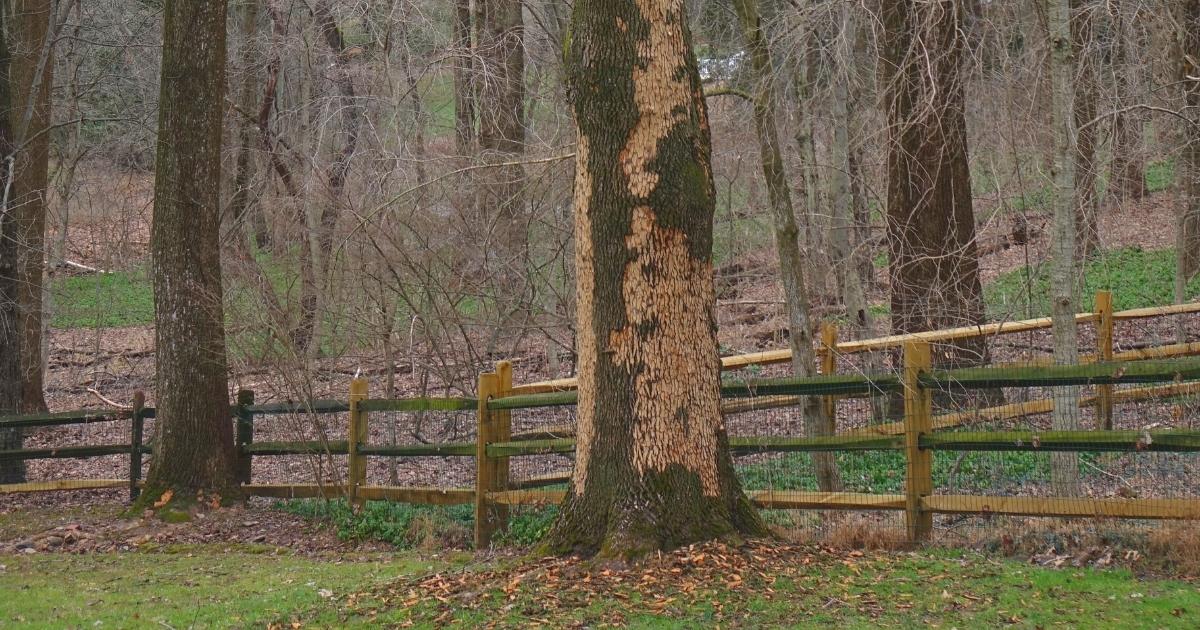
Category: Cooperative Extension

Blonding of the Emerald Ash Borer
March 02, 2022 Written by Judy Hough-Goldstein, Master Gardener
The large ash tree in our backyard has clearly had problems for years. One large limb died a few years ago, and the crown has been ever-thinner each year. This fall, however, seemingly overnight, a shower of large bark pieces appeared around the base of the tree and the tree itself appeared to have been shorn of bark in large irregular patches, leaving the light brown inner bark clearly visible. A quick internet search showed that this so-called “blonding” is a common symptom of an advanced infestation by the emerald ash borer, an exotic invasive beetle first found in North America in Michigan in 2002. The outer bark is removed by woodpeckers feeding on the beetle larvae and pupae under the bark. The beetles often infest the upper parts of the tree first, where they may not be noticed. As the beetle population increases over several years’ time, they are found lower and lower on the tree, until the damage is unmistakable – and the tree is inevitably going to die.
The emerald ash borer was probably transported from Asia on solid wood packing material, and researchers believe it had established in small numbers at least a decade before it was identified in the U.S. Unfortunately, attempts to slow its spread since 2002 have generally failed, since the adult beetles can fly anywhere from ½ mile to up to 12 miles from their host tree once they emerge. The beetle is now found in at least 35 states and 5 Canadian provinces.
The adult beetles are dark metallic green, in the family known as jewel beetles because of their glossy iridescent colors. Adults are about ½ inch long and feed on ash leaves, but the major damage is caused by the larvae. The adults emerge in the spring and lay eggs on the bark of ash trees. The tiny larvae burrow into the trees and feed on phloem, blocking the transport of sugars and other nutrients throughout the tree. This causes tree decline and ultimately death. The larvae grow to a length of about 1 to 1¼ inch long and pupate under the bark.
Once I recognized “blonding” on my ash tree, I observed other trees with the same symptoms scattered throughout my neighbor’s back yard. Luckily, only ash trees seem to be affected. When the emerald ash borer first expanded its range in the Midwest it was found infesting some white fringetree (Chionanthus virginicus) specimens. This is a valuable native and highly ornamental tree in the same family as ash. Luckily, further studies have shown that fringetrees usually support much lower numbers of larvae than ash and recover from infestation. In its native range in Asia, the emerald ash borer is considered only a minor and occasional pest of the ash species that occur there. This is probably due both to resistance in those species and to specific predators and parasites that have evolved to feed on the borer in its native range. The USDA has studied and released four species of tiny wasps that feed on emerald ash borer larvae or eggs in Asia, and these are beginning to exert some control on the borer population in North America.
Meanwhile, what can I do about my backyard ash? At this stage of infestation it is doomed, so the only question is whether to have it removed or leave it to provide food and habitat for wildlife. If you have a much-loved ash tree that is not yet infested or only lightly infested you may consider insecticide treatments to prevent its death, but that can be a costly proposition. Emerald ash borer was first detected in New Castle County in 2016, but by 2018 the Delaware Department of Agriculture found significant populations throughout the state. Ash accounts for only two percent of Delaware trees, but where they occur they will likely die if not protected. So be aware, keep an eye out for “blonding,” and plan accordingly. State forestry and plant health officials are available to provide advice and answer questions as needed.
